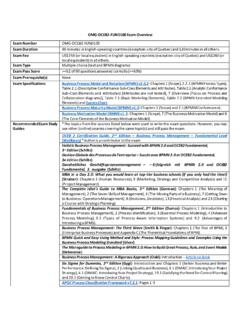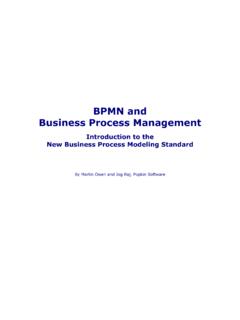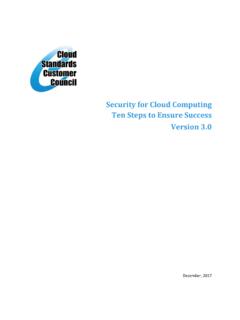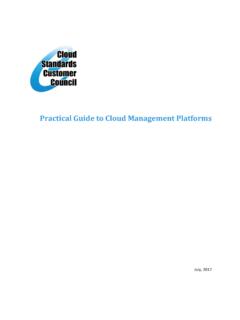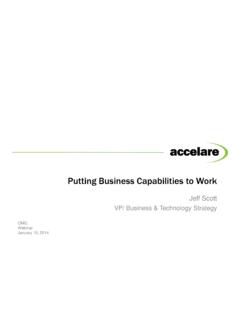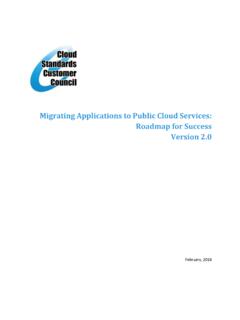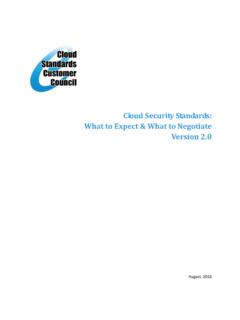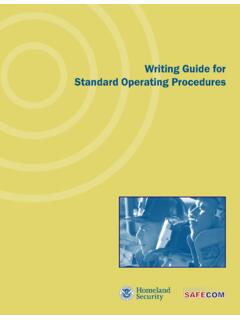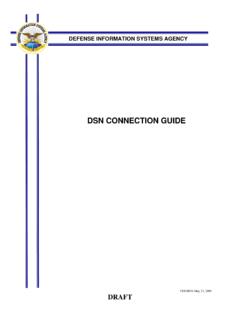Transcription of Interoperability and Portability for Cloud Computing: A ...
1 Interoperability and Portability for Cloud Computing: A guide Version December, 2017 Copyright 2017 Cloud Standards Customer Council Page 2 Contents Acknowledgements 3 Revisions 3 Executive Overview 4 Motivation and Considerations 4 Interoperability and Portability Overview 5 Basic Definition of Interoperability 5 Basic Definition of Portability 6 Interoperability and Portability Challenges 6 Elements Involved in Interoperability and Portability for Cloud Services 8 Interoperability and Portability Scenarios 11 Scenario 1: Customer Switches Providers for a Cloud Service 11 Scenario 2: Customer Uses Cloud Services from Multiple Providers 16 Scenario 3: Customer Links One Cloud Service to Another Cloud Service 19 Scenario 4: Customer Links In-house Capabilities with Cloud Services 22 Scenario 5: Migration of Customer Capabilities into Cloud Services 26 Summary of Key Considerations and Recommendations 31 Standards for Interoperability and Portability 32 Appendix A: Interoperability Model for Cloud Computing 34 Appendix B: Portability Model for Cloud Computing 36 Works Cited 38 Copyright 2017 Cloud Standards Customer Council Page 3 2017 Cloud Standards Customer Council.
2 All rights reserved. You may download, store, display on your computer, view, print, and link to the Interoperability and Portability for Cloud Computing: A guide whitepaper at the Cloud Standards Customer Council Web site subject to the following: (a) the document may be used solely for your personal, informational, non-commercial use; (b) the document may not be modified or altered in any way; (c) the document may not be redistributed; and (d) the trademark, copyright or other notices may not be removed. You may quote portions of the document as permitted by the Fair Use provisions of the United States Copyright Act, provided that you attribute the portions to the Cloud Standards Customer Council Interoperability and Portability for Cloud Computing: A guide Version (2017).
3 Acknowledgements The major contributors to this whitepaper and successive version updates are: Claude Baudoin (c b IT & Knowledge Management), Eliezer Dekel (IBM), Mike Edwards (IBM), John Meegan (IBM), Jem Pagan (JNK Securities), Karolyn Schalk (IBM), John Shortt (Expert Thinking), Gurpreet Singh (Ekartha), Joe Talik (Neoris), William Van Order (Lockheed Martin), Annie Sokol (NIST), and Steven Woodward ( Cloud Perspectives). Revisions This second revision contains updates which reflect the ISO/IEC 19941 Cloud Computing Interoperability and Portability standard and its facet models of Interoperability , data Portability , and application Portability . The model of an application and the process of porting an application have also been updated to reflect the new thinking contained in ISO/IEC 19941.
4 The technology of containers and their associated technologies are addressed, as is the place of automation in the use of Cloud services, both of which have become dominant aspects of customer use of Cloud services since the original version of this document. The relationship of this whitepaper to the many other new CSCC whitepapers on Cloud computing has also been addressed. Copyright 2017 Cloud Standards Customer Council Page 4 Executive Overview Cloud computing is important for many organizations, with use of a wide range of Cloud services and the transition of both data and applications to Cloud computing environments. The topics of Interoperability and Portability are significant considerations in relation to the use of Cloud services, but there is also confusion and misunderstanding of exactly what this entails.
5 The aim of this guide is to provide a clear definition of Interoperability and of Portability and how these relate to various aspects of Cloud computing and to Cloud services. Interoperability and Portability for Cloud Computing: A guide describes Interoperability and Portability in terms of a set of common Cloud computing scenarios. This approach assists in demonstrating that both Interoperability and Portability have multiple aspects and relate to a number of different components in the architecture of Cloud computing, each of which needs to be considered in its own right. The aim is to give both Cloud service customers and Cloud service providers guidance in the provision and selection of Cloud services indicating how Interoperability and Portability affect the cost, security and risk involved.
6 Motivation and Considerations Cloud computing is having an enormous impact on how organizations manage their information technology resources. The abundance of easy to access computing resources enabled by Cloud computing provides significant opportunities for organizations, but poses challenges in a number of areas. The current Cloud computing landscape consists of a diverse set of products and services that range from infrastructure services (IaaS), to specific software services (SaaS) to development and delivery platforms (PaaS), and many more. The variety of Cloud services has led to proprietary architectures and technologies being used by vendors, increasing the risk of vendor lock-in for customers.
7 Incidents such as a Cloud service provider shutting down particular Cloud services or the discovery of significant security vulnerabilities in applications have highlighted this risk. Cloud service customers need to mitigate the probability of lock-in, where they run the risk of being tied to a particular Cloud service provider due to the difficulty and costs of switching to use equivalent Cloud services from other providers. As an example, consider an organization using a PaaS (Platform as a Service). A PaaS platform from a particular vendor could support only limited and proprietary web frameworks, languages, libraries, databases, etc. This can lead organizations to develop application architectures dictated by features offered by the PaaS Cloud service provider which can lead to their applications being locked to that vendor, essentially non-portable.
8 There is no direct means of mitigating this risk, but organizations need to consider this issue carefully when selecting Cloud services. As enterprises adopt Cloud computing in its various manifestations, the issues of Interoperability and Portability need to be addressed head on by both providers and customers. There are opportunities and benefits in resolving the concerns of these cross cutting aspects, organizations should review existing data governance, purchase policies, and processes to see if these support a strategy to achieve high levels of Interoperability and Portability . Copyright 2017 Cloud Standards Customer Council Page 5 The goals of Cloud Interoperability and Portability for this guidance which are to enable Cloud service users to avoid vendor-lock in and allow for customers to make best use of multiple diverse Cloud services that can cooperate and interoperate with each other are critical to future Cloud service adoption and the realization of the benefits of computing as a utility.
9 Other elements relating to Interoperability and Portability in Cloud computing are outside of the scope for this guide . This includes edge/fog/mist computing and other emerging technologies (blockchain, IoT, AI), which are outside of scope of this practical guide . Interoperability and Portability Overview The Cloud ecosystem is large, with many providers offering a wide variety of Cloud services. Understanding the Interoperability and Portability of what is the necessary first step of planning and designing for the use of any Cloud service. Clarifying the specific Interoperability and Portability concerns accelerates identification of the best fit options and potential development of solutions.
10 This section provides an overview of the topics of Interoperability and Portability which is useful in understanding the more detailed descriptions contained in the scenarios and subsequent sections. The ISO/IEC 19941 standard on Cloud computing Interoperability and Portability [6] provides an excellent description of the topic. Basic Definition of Interoperability Interoperability can be defined as a measure of the degree to which diverse systems or components can work together successfully. More formally, IEEE and ISO define Interoperability as the ability for two or more systems or applications to exchange information and mutually use the information that has been exchanged.
